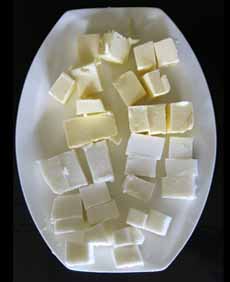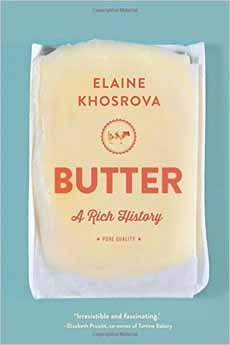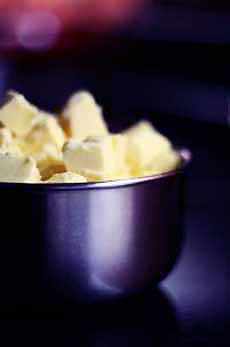TIP OF THE DAY: Back To Butter, Now OK To Eat
|
[1] Butter and lard: out of the shadows and back onto the table (photo courtesy A Canadian Foodie). [2] Butter lovers will enjoy Butter, A Rich History. Also check out Nourishing Fats: Why We Need Animal Fats for Health and Happiness. |
If your new year’s resolution includes cutting back on butter, you might re-think it. After years of being shunned as a contributor to heart disease, butter is in again. Recorded use of butter dates to 2,000 years B.C. (the history of butter). At butter’s peak in the 1920s, annual per capita consumption in the U.S. was 18 pounds about 72 sticks. At its nadir, in 1992, with research reports giving it the thumbs-down, per capita consumption dropped to 4 pounds. As recently as 2006, margarine sales outpaced butter’s. For those on a budget, margarine was/is $1 to $2 per pound less expensive. In 1913, French chemist Michel Eugène Chevreul discovered margaric acid; but it was not turned into a foodstuff until much later. Commercial margarine was invented in France in the 1860s, when Emperor Napoleon III offered prize money to whomever could find a cheaper substitute for butter, to feed the army and the poor. A French chemist, Hippolyte Mège-Mouriés, took the prize by inventing oleomargarine, an imitation butter made from refined vegetable oil and water. He patented it in 1869. Yet, while margarine was served to the army, it never took off in France: The French knew which side their bread was buttered on (the history of margarine). The good news: He sold the patent to the U.S. Dairy Company in 1871. Butter became very expensive during the Great Depression, and World War II rationed the supply, as dairy farmers went off to war. Margarine came into its own. Margarine never passed through the doors of our mother’s house. Her palate would only accept the best creamery butter, plus lard for her lauded pie crusts. When we first tasted margarine on bread in the college cafeteria, we agreed: Better no bread spread than one of vegetable oil. To those who can taste the difference, there is no substitute for butter in baking. We could tell at first bite if a cookie or cake was not made with butter…and tossed it. But it was the attribution of heart disease to animal fats that caused many people to back off of butter. Beginning in the 1980s, Americans were programmed by mass media reports to equate butter and fat with heart disease and poor health, and to head to low fat diets. Fortunately, research pointed to heart-healthy olive oil as an alternative, and many of us decamped to EVOO. But over the past few years, new research has deflated the biggest myths about cholesterol. It’s OK to eat an egg every day, and to butter your bread. And you need at least a tablespoon a day of butter or oil for skin and hair health. Add a second tablespoon of EVOO for heart health. These studies have shown that consuming butter (within reason, as with any food) is not bad for you, but is actually beneficial (source). Butter is full of vitamins and healthy fatty acids that help prevent tooth decay, cancer and even obesity (!). [NOTE: THE NIBBLE is not a medical expert. Consult with yours if you have questions or issues.] Animal fats are no longer demonized, at roughly the same time as plant-based trans fats were removed from the marketplace. The result: an animal fat renaissance. Americans have responded to the news. According to the U.S. Department of Agriculture, per capita consumption rose to 23 sticks of butter, the highest quantity since World War II. And many restaurants never left it behind. Today, animal fats are more popular than ever. Chefs are cooking with not just butter, but with beef tallow, duck fat, even schmaltz—rendered chicken fat that was a mainstay of European Jewish cooking. Yes, chefs know that the secret to great flavor often lies in animal fat. So consult with your healthcare provider, and safely enjoy your share in the new year. Do your own taste test; but in ours, the winners were, in alphabetical order: |
|
|
Depending on your preference for unsalted or salted butter, your favorites may vary. There are other great butters made in the U.S., including regional and artisan butters such as Kate’s Homemade Butter from Maine. But they are made in small quantities and hard to get ahold of.
|
||



